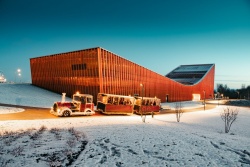Author: BalticTravelnews.com
Source: visitestonia.com
One of the presents gifted to Estonia for its Jubilee is a nature film titled “The Wind Sculpted Land”. The film was created by Joosep Matjus (from Estonia) and Atte Henriksson (from Finland) who, over a period of three years, spent more than 400 days filming the wild nature of Estonia. Joosep and Atte are glad to share some of the wonderful locations they found during that time.
Flood-meadows of the Matsalu National Park in Western Estonia
Reklāma
Spring and fall bring an abundance of birds to the flood-meadows and coastal meadows of the Matsalu National Park as several hundred birds pass through it on their migration route. Open landscapes, especially meadows and coastal areas are perfect places for birds to stop and rest or eat. Observation towers have been set up at Haeska, Koostri and Penijõe. After springtime snowmelt, some roads can be flooded, so it’s wise to pack rain boots with the rest of your travel equipment.
Tõramaa wooded meadow at the Soomaa National Park
Wooded meadows are rather rare in Estonia, but they are abundant in different species and include both meadow and forest plants. The Tõramaa wooded meadow, which is located in the Soomaa National Park, is unique for its tall oak trees. During the fifth season, it is possible to ride canoes in the Soomaa National Park. This is a truly special experience. The numerous bogs (e.g. Riisa or Ingatsi bog) of the national park are best visited in the fall. Peat moss can take on a red colour after the first cold nights, thereby making it difficult to spot cranberries in the moss. Those who are more fond of wandering about in forests, might want to head to the Kuuraniidu study trail, where they can marvel at the thick trunks of aspen trees.
Nõva coast in Northwestern Estonia
Beaches on the Northwestern coast of Estonia are a real treat due to their singing sands. There is no need to worry about overpopulation on these beaches in summertime. Furthermore, in the fall and winter, it can seem as though no-one has ever stepped foot in these sands. There are only a few signposts and a couple of trails. The road to the coast runs through a mesotrophic forest, which is abundant in mushrooms and lingonberries in the fall. Additionally, there is nature centre in Nõva, where visitors can learn more about how the local nature has evolved and get useful tips for their hikes.
Saka cliff in Northern Estonia
The Estonian cliffed coast is undoubtedly unique. The meeting places of stone and sea are like outdoor geology classes, where rock layers, which are millions of years old, are easily within reach. Visitors to the Saka cliff can also see the Kivisilla, i.e. Saka Waterfall, which, at its 22.8-metre height, is the second tallest in Estonia, right after the Valaste Waterfall (30 metres). During high waters, this is a mandatory sight for nature lovers. In summer, however, it is a perfect place for a secluded beach holiday.
The film is available here
To publish this article please contact BalticTravelnews.eu editorial board
 --------
--------


.jpg)


